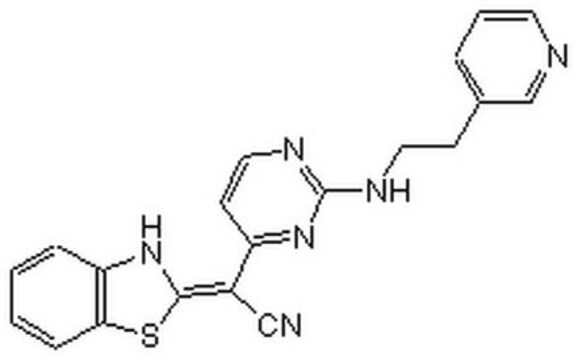124018
InSolution Akt-Inhibitor VIII, Isozym-selektiv, Akti-1/2
Akt Inhibitor VIII, Isozyme-Selective, Akti-1/2, CAS 612847-09-3, is a cell-permeable, reversible inhibitor of Akt1/Akt2 (IC₅₀ = 58 nM, 210 nM, & 2.12 µM for Akt1, Akt2, and Akt3, respectively).
Synonym(e):
InSolution Akt-Inhibitor VIII, Isozym-selektiv, Akti-1/2
About This Item
Empfohlene Produkte
Qualitätsniveau
Assay
≥95% (HPLC)
Form
solid
Hersteller/Markenname
Calbiochem®
Lagerbedingungen
OK to freeze
protect from light
Farbe
yellow
Löslichkeit
DMSO: 5 mg/mL
Versandbedingung
ambient
Lagertemp.
2-8°C
InChI
1S/C34H29N7O/c42-34-39-26-8-4-5-9-31(26)41(34)25-14-16-40(17-15-25)20-22-10-12-24(13-11-22)33-32(23-6-2-1-3-7-23)37-29-18-27-28(36-21-35-27)19-30(29)38-33/h1-13,18-19,21,25H,14-17,20H2,(H,35,36)(H,39,42)
InChIKey
BIWGYFZAEWGBAL-UHFFFAOYSA-N
Allgemeine Beschreibung
Biochem./physiol. Wirkung
Akt1, Akt2, Akt3
Verpackung
Warnhinweis
Rekonstituierung
Sonstige Hinweise
Logie, L., et al. 2007. Diabetes56, 228.
Barnett, S.F., et al. 2005. Biochem. J.385, 399.
DeFeo-Jones, D., et al. 2005. Mol. Cancer Ther.4, 271.
Zhao, Z., et al. 2005. Bioorg. Med. Chem. Lett.15, 905.
Lindsley, C.W., et al. 2005. Bioorg. Med. Chem. Lett.15, 761.
Rechtliche Hinweise
Lagerklassenschlüssel
11 - Combustible Solids
WGK
WGK 3
Flammpunkt (°F)
Not applicable
Flammpunkt (°C)
Not applicable
Analysenzertifikate (COA)
Suchen Sie nach Analysenzertifikate (COA), indem Sie die Lot-/Chargennummer des Produkts eingeben. Lot- und Chargennummern sind auf dem Produktetikett hinter den Wörtern ‘Lot’ oder ‘Batch’ (Lot oder Charge) zu finden.
Besitzen Sie dieses Produkt bereits?
In der Dokumentenbibliothek finden Sie die Dokumentation zu den Produkten, die Sie kürzlich erworben haben.
Kunden haben sich ebenfalls angesehen
Unser Team von Wissenschaftlern verfügt über Erfahrung in allen Forschungsbereichen einschließlich Life Science, Materialwissenschaften, chemischer Synthese, Chromatographie, Analytik und vielen mehr..
Setzen Sie sich mit dem technischen Dienst in Verbindung.














![PERK-Inhibitor I, GSK2606414 GSK2606414 is a cell-permeable, highly potent inhibitor of EIF2AK3/PERK (IC₅₀ = 0.4 nM; [ATP] = 5 µM). Targets PERK in its inactive DFG conformation at the ATP-binding region.](/deepweb/assets/sigmaaldrich/product/structures/180/559/efa716dc-d5fe-4339-a6f0-0103084fc04a/640/efa716dc-d5fe-4339-a6f0-0103084fc04a.png)
